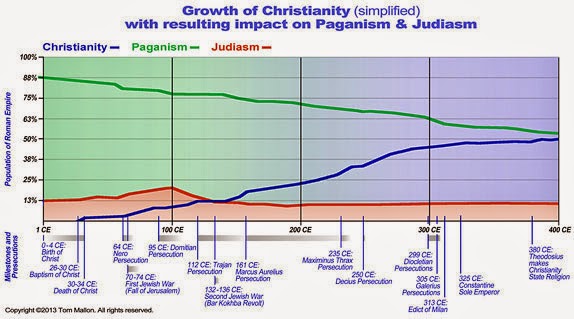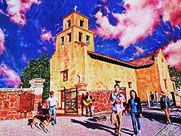Ripened Needs
Setting the Stage for Constantine
 |
| King David |
Ironically, by the beginning of the fourth century, some three hundred years after the passing of Christ and almost two hundred and fifty years after the fall of Jerusalem, Constantine the Great would more faithfully fulfill this specific messianic prophecy. However, he would do so as the sword bearing messiah of Christendom and not the much prayed for Jewish deliverer.
Rebel Religion
Constantine's emergence and triumph were the bi-products of a colliding chain of events that had begun with the birth of Christ. The arrival of Christ and the development of his subsequent rebel faction within Judaism would, after the death of the Apostles, morph and grow into an entirely new religion.| 11th-century icon of Jesus from Greece |
Up until the advent of Christianity, Rome's officiating had been tolerant of a variety of beliefs. Christians not participating in state-run sacrifice rituals were one thing, something that may be overlooked. However, Christian criticism and outright refusal to participate was interpreted as insurrection. These incidents would closely coincide with political uprisings within Judea, making Roman officials impatient with Jews as well as this new religion spawned from Jewish beliefs. When barbarous raids would increase in the West or Persian hostilities would threaten Eastern frontiers, oracles and soothsayers reading animal entrails would inevitably place the blame on the non-practicing inhabitants of the empire.
Fertile Period for Change
Consequently, taxation would increase with a decline in living conditions. Invasions and defending armies would strangle the movement of goods in a highly mercantile economy, causing a drop in trade and much needed tax revenue. What follows are centuries of unrest, civil war and, eventually, the East/West Empire partitioning by Emperor Diocletian. Subsequently, a climate would develop that was ripe for a change in social beliefs, placing the social reforms of Jesus and his apostles before an eager audience. Ultimately, cumulative events would place Constantine on the frontline of history.
 |
| Click to Enlarge |
Audience
Persistance, Persecution and Poverty
The arrest and execution of early Christians did little to halt the growth of the Jesus cult phenomena. This is partially due to the fact that early persecution by the Roman government was limited mostly to the inhabitants of the city of Rome, the emperor's backyard. Also, polytheistic Hellenists were, as a rule, extremely tolerant, even experimental, of other beliefs. There were Romans that made regular sacrifices to the Egyptian god Isis. Emperor Tiberius had made several unsuccessful bans on this practice, but eventually Egyptian beliefs were simply relegated to everyday magic (which was legal). What mattered most was that a Roman citizen cooperate and participate in the rite of public sacrifice. |
| Christian Martyrs |
 |
| Roman Citizen |
Another group would be the soldiers and magistrates involved in endless punishments and executions. Sympathy in this class would be recorded by historians describing how soldiers would hold the hands of Christians and do the sacrifices while the Christians looked away and then released them. Magistrates were known to allow slaves or pagan friends to do the sacrifices for resistant Christians. Like the persecution of the Jews by the Nazi's in WWII, arrests and executions of seemingly ordinary people would oftentimes promote unintended sympathy, sometimes support.
Diverse Demographics
There were other Christian activities promoting change in the Roman Empire. Adding to the Christian growth factor was the incredibly successful missionary work performed by the early Christians, Saint Paul being the most effective. Subsequent to Christianity being an Eastern religion, there developed several centers for Christianity throughout the empire, oftentimes far from the watchful eye of emperor or senate. In less than three centuries after the death of Christ, there were theology centers throughout the Roman Empire. By the time of Constantine, slightly less than half of the empire's population was Christian (see chart above).However, the cosmology of beliefs within the remaining pagan population remains uncertain. As sited earlier, there was no strict canon to hellenistic beliefs, subsequently beliefs tended to differed amongst individuals. In short, by the early fourth century the population of the Roman Empire was composed of Christians, quasi-Christians (Christians with shared pagan beliefs), jews, non-denominational, casually observant pagans, and, to a very small extent, strictly observing pagans (if such a thing ever existed within the Empire).
 |
| Click for Wikipedia Article |
Uniting Force
Verge of a Wider Epoch
 |
| Constantine the Great |
From a social, economical and political standpoint Constantine's arrival was equivalent to the prophetic sword bearing Messiah foretold within Jewish faith. Through his own personal struggles he had become the flesh and blood liberator that would free the oppressed and fight God's war, in this instance, Christ's war of social change.
 |
| Constantine Sees the Cross |
Commentary
 |
| Today's Poverty |
Perhaps if man could put aside dogma and canon and, like Constantine, simply believe a bit more in himself and the welfare of others, all things may just become possible.
Go to: Chapter 3) Rise of Byzantium, Orphaned West
Go to: Chapter 3) Rise of Byzantium, Orphaned West
|
|
Got Feedback?
Comments? Questions? Corrections? Any feedback at all? Just click on the comments box at the bottom of this page and enter your thoughts. All comments are welcome.
Santuario de Guadalupe, the oil painting by Tom Mallon. This 42" x 22" canvas is the latest addition to the Santa Fe Portrait Series. The Santuario is the oldest shrine to Our Lady of Guadalupe in the US.
Visit this later update by CLICKING HERE
Shostakovich and Cultural Snobbery, Could anyone survive Stalin's Purges, compose a large body, write for himself and the masses while producing constantly great work?
Visit this later update by CLICKING HERE
Also of interest…
Tom Mallon's website "MallonArt". This website will provide you with links to all his paintings, drawings and other artwork portfolios, including the ongoing series entitled the Santa Fe Portrait.
Visit this later update by CLICKING HERE
Santuario de Guadalupe, the oil painting by Tom Mallon. This 42" x 22" canvas is the latest addition to the Santa Fe Portrait Series. The Santuario is the oldest shrine to Our Lady of Guadalupe in the US.
Visit this later update by CLICKING HERE
Shostakovich and Cultural Snobbery, Could anyone survive Stalin's Purges, compose a large body, write for himself and the masses while producing constantly great work?
Visit this later update by CLICKING HERE
Tom Mallon's website "MallonArt". This website will provide you with links to all his paintings, drawings and other artwork portfolios, including the ongoing series entitled the Santa Fe Portrait.
Visit this later update by CLICKING HERE






No comments:
Post a Comment